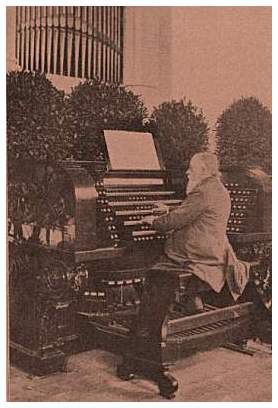The Wanamaker Grand Organ has graced Macy's Philadelphia
shoppers for almost a hundred years since it first inhabited
the Grand Court on June 22, 1911.
Built by the Los Angeles Art Organ Company for the
1904 St. Louis World's Fair, the Wanamaker Organ was
designed by renowned organ architect George Ashdown
Audsley. Original plans for the instrument called for more
than 10,059 pipes; its lavish scale boosts costs to
105,000 dollars and bankrupted the builder. The massive
instrument was capable of 17,179,869,183 distinct tonal effects.
Though the organ was played upon daily by celebrated organists
such as M. Alexandre Guilmant of Paris, Edwin H. Lemare, and
Mr. Clarence Eddy, of New York; Charles Galloway, of St. Louis,
was the official organist. The admission to all organ recitals was 10 cents. Special eighty-piece
Orchestral concerts cost 25 cents.
It was said that the chief reason why French virtuoso and composer: Alexandre Guilmant, came to play at the St. Louis Exposition was to play on the great organ.
In 1909, Philadelphia merchant mogul John Wanamaker brought the instrument for his new Philadelphia emporium. It took thirteen freight cars to ship the organ from St. Louis to its new home. At the exact moment when England's King George was crowned, the Wanamaker Organ was first heard in the stores seven-story atrium. Later that year, it was used when President Taft dedicated the store.
Despite its immense size, the tone was judged inadequate to fill the huge court. Wanamaker employed up to 40 full-time employees to enlarge the instrument. William B. Fleming, the original factory supervisor, was hired to direct the work. More than 8,000 pipes were added by 1917. Between 1924 to 1930, an additional 10,000 pipes were installed, bringing the total number of pipes today to 28,500.
The organ sports six ivory keyboards and 729 color-coded stop tablets. There are 168 combination buttons and 42 foot controls. The pipework encompasses the resources of three symphony orchestras; its String Organ alone has 7,000 pipes.
The organ is now a National Historic Landmark and valued in excess of 57 million dollars.
